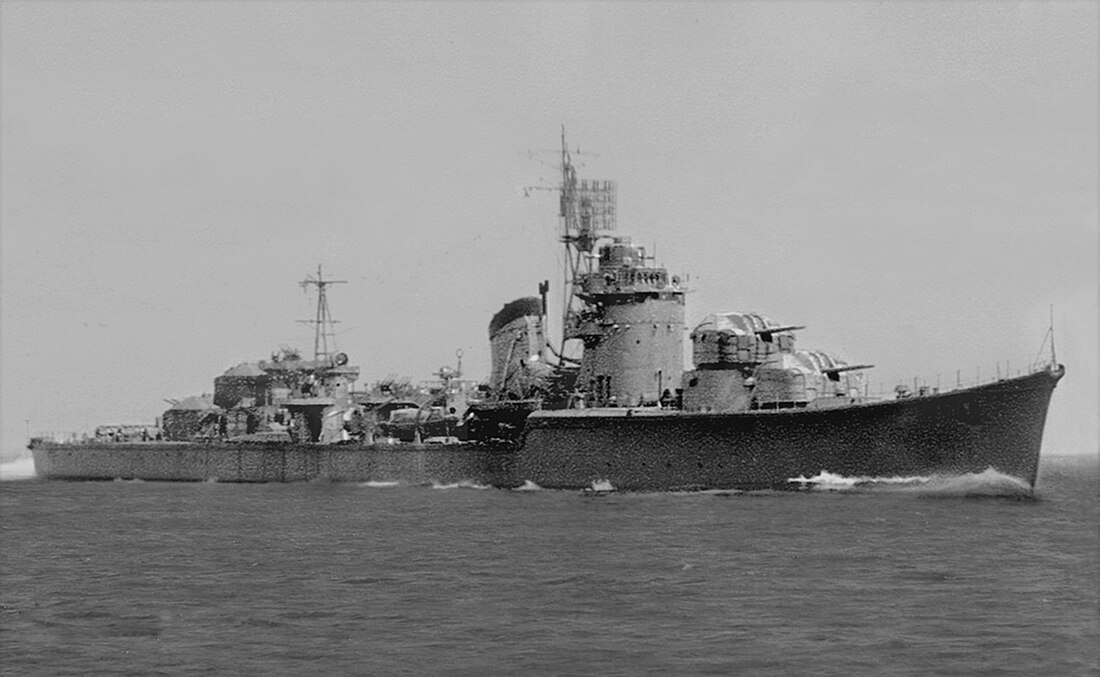Top Qs
Timeline
Chat
Perspective
Japanese destroyer Fuyutsuki
Akizuki-class destroyer From Wikipedia, the free encyclopedia
Remove ads
Fuyutsuki[2][3] (冬月, "Winter Moon") was an Akizuki-class destroyer of the Imperial Japanese Navy. Her name means "Winter Moon".
This article needs additional citations for verification. (July 2024) |
Remove ads
Design and description
Summarize
Perspective
The Akizuki-class ships were originally designed as anti-aircraft escorts for carrier battle groups, but were modified with torpedo tubes and depth charges to meet the need for more general-purpose destroyers. The ships measured 134.2 meters (440 ft 3 in) overall, with beams of 11.6 meters (38 ft 1 in) and drafts of 4.15 meters (13 ft 7 in).[4] They displaced 2,701 long tons (2,744 t) at standard load[5] and 3,420 long tons (3,470 t) at deep load.[6] Their crews numbered 300 officers and enlisted men.[5]
Each ship had two Kampon geared steam turbines, each driving one propeller shaft using steam provided by three Kampon water-tube boilers. The turbines were rated at a total of 52,000 shaft horsepower (38,776 kW) for a designed speed of 33 knots (61 km/h; 38 mph). The ships carried enough fuel oil to give them ranges of 8,300 nautical miles (15,400 km; 9,600 mi) at speeds of 18 knots (33 km/h; 21 mph).[7]
The main armament of the Akizuki class consisted of eight 10 cm Type 98 dual-purpose guns in four twin-gun turrets, one superfiring pair fore and aft of the superstructure. Fuyutsuki was equipped with 41 Type 96 25-millimeter (1 in) anti-aircraft (AA) guns in seven triple-gun mounts and twenty single mounts. The ships were also each armed with four 610-millimeter (24 in) torpedo tubes in a single quadruple rotating mount amidships for Type 93 (Long Lance) torpedoes; one reload was carried for each tube. The later batches of ships were each equipped with two depth charge throwers and two sets of rails for which 72 depth charges were carried. Fuyutsuki was equipped with a Type 13 early-warning radar on her mainmast and a Type 22 surface-search radar on her foremast.[8][9]
Remove ads
Construction and career
Summarize
Perspective
On 25 May 1944, Fuyutsuki was completed at Maizuru Naval Arsenal, and she was assigned to the 11th Destroyer Squadron, Combined Fleet.[10]
On 24 June, she sailed to Yokosuka with Landing Ship No. 4 and Landing Ship No. 104.[11] On 25 June, she escorted the I-Gō Transport Squadron,[12] on 29 June, she was deployed to Chichi-jima with the cruiser Nagara and destroyer Matsu. They returned to Yokosuka on 3 July.[13]
On 11 July, she sailed to Tokuyama with the destroyer Kiyoshimo. On 14 July, she joined the Ro-Gō Transport Squadron,[14] and sailed to Nakagusuku Bay. On 15 July, she was assigned to the 41st Destroyer Division, 10th Division, 3rd Fleet with the destroyer Shimotsuki.[15] Fuyutsuki returned to Kure on 26 July.[13]
On 12 October, while escorting the light cruiser Ōyodo from Yokosuka to the Inland Sea, she was hit in the bow by a torpedo fired from the submarine USS Trepang. She returned to Kure where she was repaired.
On 31 January 1945 she ran aground on a sandbar near Ōita during a training mission in the Inland Sea.[citation needed]
Fuyutsuki participated on the last mission of the battleship Yamato (6–7 April 1945). Afterwards, she sank the crippled destroyer Kasumi with two torpedoes after taking aboard the latter's crew.[16] She was one of the few surviving Japanese ships, even though lightly damaged by 127 mm rockets and bombs. Her own losses were 12 dead and 12 injured.
On 20 August 1945, Fuyutsuki hit a mine at Moji, Kyūshū, suffering heavy damage to her stern. She surrendered unrepaired and without armament.[citation needed]

She was later used as a breakwater in May 1948 in Wakamatsu-ku, alongside Suzutsuki and Yanagi.
Remove ads
References
Further reading
External links
Wikiwand - on
Seamless Wikipedia browsing. On steroids.
Remove ads

